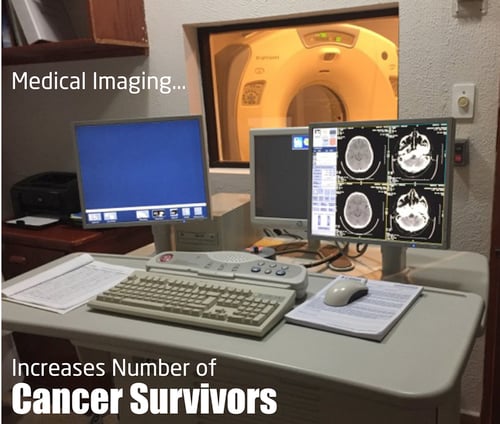A lot has changed in cancer diagnosis and treatment since the 1970s. Back then, a cancer diagnosis meant your survival rate was  less than 50 percent. Now, the cancer survival rate is 70%. The two biggest reasons for this improvement? Screening and diagnostic tools have helped increase early detection and access to high-quality medical imaging has increased.
less than 50 percent. Now, the cancer survival rate is 70%. The two biggest reasons for this improvement? Screening and diagnostic tools have helped increase early detection and access to high-quality medical imaging has increased.
The best outcomes for cancer result from early identification and intervention. Modern-day medical imaging as a diagnostic tool plays an enormously important role in the detection, diagnosis, staging, treatment and monitoring of cancer.
Medical imaging is used to:
- Screen and detect cancer
- Identify masses
- Stage cancer progression and metastasis
- Monitor progression or regression during treatment
- Identify recurrence or verify remission
So which type of medical imaging device is best for diagnosing cancer? Each modality has its strengths.
X-Ray
X-rays are effective in detecting cancer of the bones, kidneys, stomach, bladder and lungs. X-rays are also less expensive, require less prep and are quicker, as well.
Ultrasound
Unlike X-rays, Ultrasound is great for examining soft tissues. It’s also ideal for distinguishing between a solid tumor and a fluid-filled cyst. It can also see blood flow in real time and can be used as a guide during a biopsy. Ultrasounds are great for detecting cancer in the pancreas, prostate, liver, ovary, kidney, bladder, colorectal and breast.
CT Scanner (Computed Tomography)
CT Scans can show a cross-section of body parts like organs, bones and soft tissues It’s used to detect cancer of the liver, long, pancreas, esophagus, brain, stomach ovary, colorectal, non-Hodgkin lymphoma, kidney, prostate and bladder. Images made with a CT Scan are seen more clearly than those made with an x-ray. It can be used to help identify tumors or masses and show what blocked vessels feed the tumor, as well as other structures affected. If a tumor is identified, a CT Scan can be used for a radiofrequency ablation treatment or biopsy of the tumor. A CT Scanner can also be used to perform “virtual endoscopy” (a bronchoscopy colonoscopy) without having to insert a scope into the body.
MRI (Magnetic Resonance Imaging)
An MRI is a powerful diagnostic tool that takes multiple cross-sectional images from many angels to take a picture of body parts or the entire body. It’s great for identifying and guiding cancer treatments, as well as identifying whether cancer has metastasized to another part of the body. It provides much clearer images than other medical imaging modalities and can be used to detect cancer of the liver, esophagus, prostate, pancreas, brain, myeloma, colorectal, non-Hodgkin lymphoma, bladder, breast and kidney. A breast MRI can also be used to supplement mammography or ultrasound and can help determine the extent of newly-diagnosed breast cancer, as well as help identify metastasis. A breast MRI can also be used to evaluate the effectiveness of breast implants and chemotherapy.
PET Scan (Positron Emission Tomography)
A PET Scan can be used to detect the presence and metastasis of colorectal, non-Hodgkin lymphoma, prostate and lung cancer. It uses a form of radioactive sugar to identify cancer cells and help determine how quickly the cancer cells may be growing.
Celebrate National Cancer Survivor's Day on June 2, 2019!
Talk To An Expert
If your clinic, healthcare facility, practice or hospital is looking for the right medical imaging device, be sure to talk to an expert like Atlantis Worldwide. A used or refurbished device can offer the performance you need, the warranties you want and, best of all, peace of mind. Contact Us Today!
Some blogs you may have missed:
- Comparing 1.5T MRI Gradient Slew Rates
- MRI Cold Head Tips
- Service Contracts for Imaging Systems: Penny Wise and Pound Foolish?
- Radiologists, Healthcare & Social Media
- Should your business lease or buy medical imaging equipment?
- Free Medical Imaging Resources
Meet the author: Vikki Harmonay




